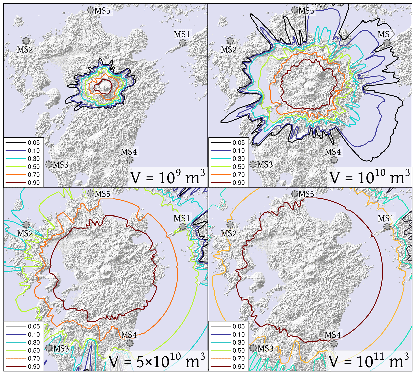Assessing minimum pyroclastic density current mass to impact critical infrastructures: example from Aso caldera (Japan)

A. Bevilacqua, Aravena A., Aspinall W., Costa A., Mahony S., Neri A., Sparks S., and Hill B.
Natural Hazards and Earth System Sciences, 22, 10, 3329–3348.
https://doi.org/10.5194/nhess-22-3329-2022
Abstract
We describe a method for calculating the probability that a distal geographic location is impacted by a pyroclastic density current (PDC) of a given size, considering the key related uncertainties. Specifically, we evaluate the minimum volume and mass of a PDC generated at the Aso caldera (Japan) that might affect each of five distal infrastructure (marker) sites, with model input parameter uncertainties derived from expert judgment. The 5 marker sites are all located 115–145 km from the caldera; as these lie in well-separated directions, we can test the effects of the different topographic shielding effects in each case. To inform our probabilistic analysis, we apply alternative kinetic energy assessment approaches, i.e., rock avalanche and density current dynamics. In the latter formulation, the minimum mass needed to reach the markers ranges between median values of ∼153×1012 and ~465×1012 kg (M 7.2–7.7), depending on the site. Rock avalanche dynamics modeling indicates that a ∼3-times greater mass would be required to reach the marker sites with 50 % probability, while the hypothetical scenario of a relatively dilute distal ash cloud would require ∼3-times less mass. We compare our results with the largest recorded Aso eruption, showing that a catastrophic eruption, similar to Aso-4, ≈ M8, would present a significant conditional probability of PDCs reaching the marker sites, in the density current formulation and contingent on uncertainty in the erupted mass and on marker site direction.


Devi effettuare l'accesso per postare un commento.